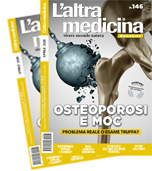Bibliografia articolo pubblicato sul numero 133 de L’altra medicina
La rivoluzione epigenetica: una responsabilità individuale nei confronti delle future generazioni
di Giorgio Terziani
1. Preetha Anand et al. Cancer is a Preventable Disease that Requires Major Lifestyle Changes. Pharmaceutical Research, Vol. 25, No. 9, September 2008
2. Brett Israel. How Many Cancers Are Caused by the Environment? Scientific American, May 21, 2010
3. Jenni Glenn Gingery. Autistic Features Linked to Prenatal Exposure to Fire Retardants, Phthalates. Endocrine Society
4. Development of the Integumentary System.” Boundless Anatomy and Physiology. Boundless, 21 July 2015
5. Pansky Ben, http://discovery.lifemapsc.com/library/review-of-medical-embryology/chapter-25-germ-layers-and-their-derivatives. Retrieved 24 October 2015.
6. Burkitt, Young; et al. (1993). Wheater’s Functional Histology: a text and colour atlas. Heath. p. 162.
7. Antoni, Mickaël; et al. (1998). Explicit reduction of N-body dynamics to self-consistent particle-wave interactions. Physics of Plasmas (5) issue 4, pp 841-852.
8. Alexander Streltsov , et al. (2015). Measuring quantum coherence with entanglement. Phys. Rev. Lett. 115, 020403.
9. Vasiliv Ogryzko (2008). Erwin Schrödinger, Francis Creek and epigenetic stability. Biology Direct 3:15 . The electronic version of this article can be found at: http://www.biology-direct.com/content/3/1/15.
10. Orozco C (2018). Coherence, the integration of energy boosting your longevity. Mahatma Editors. Portugal. ISBN 978-989-8865-38-0.
11. Wiedermann U, et al. (1996). “Vitamin A deficiency increase inflammatory responses”. Scand J Immunol. 44 (6): 578–584.
12. Cotran; Kumar, Collins (1998). Robbins Pathologic Basis of Disease. Philadelphia: W.B Saunders Company. ISBN 0-7216-7535-X.
13. Einstein, A., et al. (1935) “Can a quantum-mechanical description of physical reality be considered incomplete? Physical Review 47: 777-80.
14. Schrödinger, E. (1935) What is Life? Proceedings of the Cambridge Philosophical Society 31 (1935): 555-63.
15. Beloussov, LV (1997). “Life of Alexander G. Gurwitsch and his relevant contribution to the theory of morphogenetic fields”. International Journal of Developmental Biology. 41 (6): 771
16. Schrödinger E; Dirac, P A. M. (1936). “Probability relations between separated systems”. Mathematical Proceedings of the Cambridge Philosophical Society 32 (3): 446–452.
17. Asher Peres. (1993). Quantum Theory, Concepts and Methods, Kluwer, ISSBN 0-7923-2549-4 p. 115.
18. Zyczkowsky K (2006). “Geometry of Quantum States”. An Introduction to Quantum Entanglement. Cambridge: Cambridge University Press.
19. Steward EG (2008). Quantum Mechanics: Its Early Development and the Road to Entanglement. Imperial College Press. ISBN 978-1-86094-978-4.
20. Juan Yin; et al. (2013). “Bounding the speed of ‘spooky action at a distance”. Phys. Rev. Lett. 110, 260407 1303: 614.
21. Bell, J. S. (1987). Speakable and Unspeakable in Quantum Mechanics (PDF). CERN. ISBN 0521334950. Retrieved 24 October 2015.
22. Ford ES, Giles WH, Dietz WH (2002). “Prevalence of metabolic syndrome among US adults: findings from the third National Health and Nutrition Examination Survey”. JAMA 287 (3): 356–359.
23. Park JW,.etal. (2007) Predictors reflecting the pathological severity of non-alcoholic fatty liver disease: comprehensive study of clinical and immunohistochemical findings in younger Asian patients. J Gastroenterol Hepatol. Apr. 22(4):491-7.
24. Eisenberg DTA (2011). “An evolutionary review of human telomere biology: The thrifty telomere hypothesis and notes on potential adaptive paternal effects”. American Journal of Human Biology 23 (2): 149–167.
- Maloney PC (1987). Coupling to an Energized Membrane: Role of Ion-Motive Gradients in the Transduction of Metabolic Energy. In Escherihia coli and Salmonella Typhimurium Cellular and molecular biology Volume 1. Edited by Neidhardt FC. Washington, D.C.: American Society for Microbiology: 222-243
- Padan E, Schuldiner S (1986): Intracellular pH regulation in bacterial cells. Methods Enzymol 125:337-352.
- Feil R, et al, (2012) Epigenetics and the Environment: Emerging patters and implications. Nature Reviews Genetics 13, 97-109.
- Waddington CH. (1942) The epigenotype. Endeavour. 1:18–20.
29. Waddington CH (1968). Towards a Theoretical Biology. Edinburgh, Scotland: Edinburgh University Press;. The Basic Ideas of Biology; pp. 1–32.
30. Wu Ct, et al, (2001). Genes, genetics, and epigenetics: correspondence. Science ; 293(5532):1103–1105.
31. Hotchkiss RD.(1948). The quantitative separation of purines, pyrimidines, and nucleosides by paper chromatography.
J Biol Chem. 175(1):315-32.
32. Burzynnski RS (2005) Aging: Gene Silencing or Gene Activation? Medical Hypothesis, 64, 201-208.
33. McGowan P.O., et al (2008). Diet and the epigenetic (re)programming of phenotypic differences in behavior. Brain Research, 1237: 12-24.
34. Kaati G., Bygren L.O., Pembrey M., Sjostrom M. (2007).Transgenerational response to nutrition, early life circumstances and longevity. European Journal of Human Genetics, 15: 784-790.
35. Dolinoy D.C., Weidman J.R., Waterland R.A., Jirtle R.L. (2006).Maternal Genistein Alters Coat Color and Protects Avy Mouse Offspring from Obesity by Modifying the Fetal Epigenome. Environmental Health Perspectives, 114:567-572.
36. Dolinoy D.C., Huang D., Jirtle R.L. (2007). Maternal nutrient supplementation counteracts bisphenol A-induced DNA hypomethylation in early development. PNAS, 104: 13056-13061.
37. Pert C. (1999). The Molecules of Emotion. Scribner. ISBN 978068484634
38. Karam S (2010) A Focus on Parietal Cells as a Renewing Cell Population. World J. Gastroenterology. 16(5): 538–546.
39. Berthoud, H. R.; Neuhuber, W. L. (2000). “Functional and chemical anatomy of the afferent vagal system”. Autonomic Neuroscience. 85 (1–3): 1–17.
40. Sauvé B, et al (2007). Measurement of cortisol in human hair as a biomarker of systemic exposure. Clin Invest Med. 30(5): E183-191.
41. Yasuyuki A., et al (2010) Embryonic development of hair follicle pluripotent stem (hfPS) cells. Med MolMorphol: 43(2);123-127.




